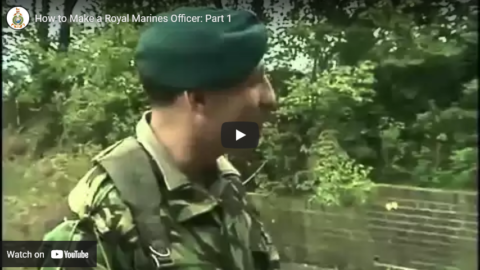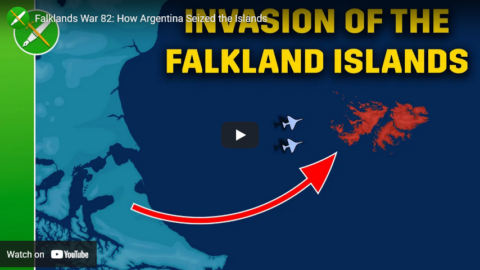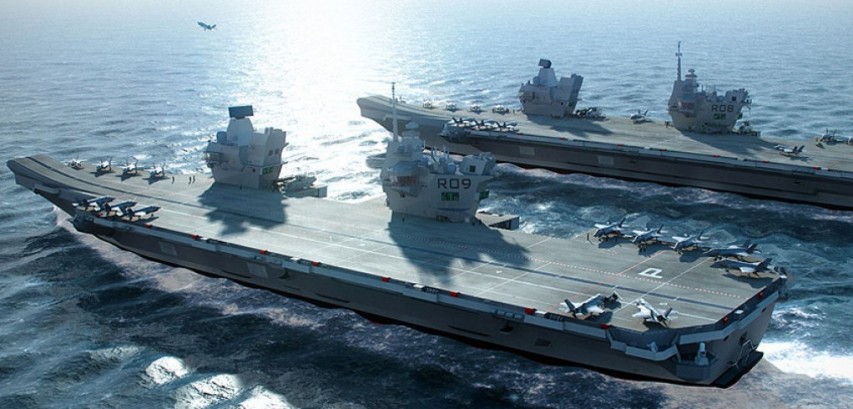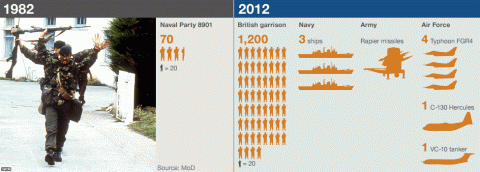Royal Marines
Published 13 Sep 2012First transmitted in 1989, this is the first part of a programme that follows the progress of 29 men who want to be Royal Marine officers. After arriving at Commando Training Centre, Devon, they find that their fortitude is tested to the very limits as they undertake the All Arms Commando Course to earn their green berets.
April 12, 2022
How to Make a Royal Marines Officer: Part 1 (1989)
April 2, 2022
Falklands War 82: How Argentina Seized the Islands
Historigraph
Published 31 Mar 2022For up to 60% off a subscription to Babbel, head over to https://bit.ly/historigraph_babbel
To help support the creation of the rest of the Falklands series, consider supporting on Patreon:
https://www.patreon.com/historigraphCome join the historigraph discord: https://discord.gg/ygypfs3BEB
Buy Historigraph Posters here! historigraph.creator-spring.com
This video was sponsored by Babbel.
► Twitch: https://www.twitch.tv/historigraph
► Second Channel: https://www.youtube.com/channel/UCpIj…
► Twitter: https://twitter.com/historigraph
► Instagram: https://www.instagram.com/historigraphSources for the Falklands War Series (so far):
Max Hastings & Simon Jenkins, Battle for the Falklands
https://archive.org/details/battlefor…
Martin Middlebrook, Operation Corporate
Martin Middlebrook, Battle for the Malvinas
Mike Norman, The Falklands War There and Back Again: The Story of Naval Party 8901
Kenneth Privratsky, Logistics in the Falklands War
Sandy Woodward, One Hundred Days
Paul Brown, Abandon Ship
Julian Thompson, No Picnic
John Shields, Air Power in the Falklands Conflict
Edward Hampshire, The Falklands Naval Campaign 1982
Hugh McManners, Forgotten Voices of the Falklands
Cedric Delves, Across an Angry Sea: The SAS in the Falklands War
Rowland White, Vulcan 607
Vernon Bogdanor, “The Falklands War 1982” lecture https://www.youtube.com/watch?v=a9bWw…
Arthur Gavshon, The sinking of the Belgrano https://archive.org/details/sinkingof…
Gordon Smith, Battle Atlas of the Falklands War 1982 by Land, Sea and Air
http://www.naval-history.net/NAVAL198…
Hansard – https://api.parliament.uk/historic-ha…
Recording of Margaret Thatcher’s statement to the commons is from https://www.youtube.com/watch?v=HvbhV…Music Credits:
“Rynos Theme” Kevin MacLeod (incompetech.com)
Licensed under Creative Commons: By Attribution 4.0 License
http://creativecommons.org/licenses/b…“Crypto” Kevin MacLeod (incompetech.com)
Licensed under Creative Commons: By Attribution 4.0 License
http://creativecommons.org/licenses/b…“Stay the Course” Kevin MacLeod (incompetech.com)
Licensed under Creative Commons: By Attribution 4.0 License
http://creativecommons.org/licenses/b…Other music and SFX from Epidemic Sound
From the comments:
Historigraph
1 day agoThis series has been about four months in the making, and is by far the most ambitious project I’ve set out to complete on Historigraph. It’s going to be 8 (possibly 9) videos over the next three months, charting the course of the Falklands War as it happened 40 years ago.
If you liked this video and want to help support the creation of the remaining seven videos, it would meant the world to me if you could consider supporting on Patreon https://www.patreon.com/historigraph, become a channel member, or even just share this video far and wide.
June 16, 2021
By Sea, By Land – A Global History of the Marines – WW2 Special
World War Two
Published 15 Jun 2021Naval infantrymen have long been a feature of warfare. In the build-up to 1939, they took on new functions and tactics. The Royal Marines, the US Marine Corps, Black Death, Kaiheidan, and more are ready for all-out amphibious warfare in the Pacific Theatre and beyond.
(more…)
February 21, 2020
“Back in Control” – The Falklands War – Sabaton History 055 [Official]
Sabaton History
Published 20 Feb 20201982, on a group of islands far, far away from Great Britain. After the military junta of Argentinian Army General Leopoldo Galtieri had publicly declared that the Falkland Islands (Malvinas) were rightfully part of Argentinian territory, an invasion force succeeded in wrestling control away from their British owners. However Great Britain would not simply stand by and give the Falklands up. Instead a British task-force would make its way down to the Falklands, in an attempt to take back control of the islands by force. What followed was an undeclared war of 10 weeks, where British carriers and commandos fought against the entrenched Argentinian ground-forces for the ownership of the islands.
Support Sabaton History on Patreon: https://www.patreon.com/sabatonhistory
Listen to “Back in Control” on the album Attero Dominatus:
CD: http://bit.ly/AtteroDominatusStore
Spotify: http://bit.ly/AtteroDominatusSpotify
Apple Music: http://bit.ly/AtteroDominatusAppleMusic
iTunes: http://bit.ly/AtteroDominatusiTunes
Amazon: http://bit.ly/AtteroDominatusAmzn
Google Play: http://bit.ly/AtteroDominatusGooglePlayCheck out the trailer for Sabaton’s new album ‘The Great War’ right here: https://www.youtube.com/watch?v=HCZP1…
Watch more videos on the Sabaton YouTube channel: https://www.youtube.com/user/Sabaton?…
Listen to Sabaton on Spotify: http://smarturl.it/SabatonSpotify
Official Sabaton Merchandise Shop: http://bit.ly/SabatonOfficialShopHosted by: Indy Neidell
Written by: Markus Linke and Indy Neidell
Directed by: Astrid Deinhard and Wieke Kapteijns
Produced by: Pär Sundström, Astrid Deinhard and Spartacus Olsson
Creative Producer: Joram Appel
Executive Producers: Pär Sundström, Joakim Broden, Tomas Sunmo, Indy Neidell, Astrid Deinhard, and Spartacus Olsson
Post-Production Director: Wieke Kapteijns
Edited by: Iryna Dulka
Sound Editing by: Marek Kaminski
Maps by: Eastory – https://www.youtube.com/c/eastoryArchive by: Reuters/Screenocean https://www.screenocean.com
Music by Sabaton.Sources:
– Casa Rosada (Argentina Presidency of the Nation)
– Gobierno de Argentina (Government of Argentina) – Argentina.gob.ar
– Ken Griffiths from Wikimedia Commons
– Armada Argentina on Flickr
– HMS Invincible in 1980, HMS Hermes in 1977, credit: Hugh Llewelyn on Flickr
– IWM: FKD 186, FKD 357, FKD 677, IWM FKD 138, FKD 185, FKD 2743, FKD 168, FKD 435, FKD 182, FKD 319, FKD 2744, FKD 71, FKD 217, FKD 107, FKD 321, FKD 349, FKD 345, FKD 2755, FKD 108, FKD 2028, FKD 2750, FKD 2051, FKD 2040, FKD 176, FKD 314, FKD 427
– IWM ART: 15530 33, 15530 56, 15530 10, 15530 10
– National Army Museum: 164752, 107649An OnLion Entertainment GmbH and Raging Beaver Publishing AB co-Production.
© Raging Beaver Publishing AB, 2019 – all rights reserved.
November 28, 2019
It’s time for the ever-popular Game of Budget Leaksmanship for the British military
Sir Humphrey wants to encourage all defence-minded readers not to panic unduly at the all-too-predictable tactics used by all sides in the next round of British government defence planning:
It’s that time again, a period theoretically seen every five years or so, but occasionally more recently than that. A group of people who it seems cordially loathe each other spend months leaking, shouting, briefing and making grandiose pledges that don’t always get fulfilled. This whole, and at times, unedifying, process is, of course, the latest iteration in a Strategic Defence Review.
The Sunday Times leads with a story today that the Army is facing cuts to its manpower, and that in return they want the Navy to be forced to lease or mothball one of the two Queen Elizabeth class carriers. The article talks about a range of debates going on, and the latest news about what may or may not be scrapped or cut in any future budget settlement. Is this something to worry about, or is it merely the opening salvos in what is likely to be a long and painful campaign of attrition?
Defence reviews are driven from the very centre of Government – they occur usually with the Prime Minister of the day’s blessing, and they are now run centrally – usually via the Cabinet Office, and not by the MOD. This reflects the fact that modern national security requirements means the need to bring all departments together in a consensus and not isolated pockets doing their own thing.
He also provides a helpful list of the specific “the-sky-is-falling!” predictions you can expect to see through all stages of any given defence review process:
What is clear is that the new season of “Game of Planning Rounds” has begun. We can expect plenty more leaks like this to a variety of sources and papers which will be intended to achieve effect. If past performance is anything to go by, you can expect to see a “greatest hits” collection of some variants of the following options leaked in the next 12-18 months:
a. Parachute regiment to merge with Royal Marines
b. White elephant carriers are all to blame
c. The nasty MOD civil service did it …
d. SAS to merge with SBS
e. RAF to take control of all F35 and scrap FAA
f. Army has more horses than tanks
g. Army to no longer have enough troops to deploy a Division
h. Cranwell, Sandhurst and Dartmouth to close / merge in one location
i. RN to scrap X number of frigates or other ships
j. Naval Infantry Division to return …
k. Army to scrap Y number of tanks
l. RAF to dispose of Z aircraft fleetsAll of these have appeared in the past, but how many of them actually happened or were true? The above links are just a snapshot in time (based on a quick google) but demonstrate that in the build up to a review, we’ll see a lot more articles like this one (which predicted cuts, many of which never happened) and a lot of rumours, angst and predictions.
Humphreys honest advice is simple – DON’T PANIC! Until the review is finalised, and has gone to the Prime Minister of the day for approval, nothing is set in stone. There will be leaks aplenty, rumours aplenty and very little in the way of actionable outcomes. Until the final package of measures is approved, everything is to play for, and anything can happen. It is just not worth getting worked up about because unless you are on the inside track as part of the Review team, you don’t know what is going on.
May 28, 2018
Naval Operations In The Dardanelles Campaign 1915 I THE GREAT WAR On The Road
The Great War
Published on 25 May 2018In our first episode filmed on the former Gallipoli battlefields, Indy and our guide Can Balcioglu explore the naval campaign that preceded the landings at Gallipoli in early 1915.
January 16, 2018
Yet another money squeeze for Britain’s military
At the Thin Pinstriped Line, Sir Humphrey outlines the difficult financial position the British Ministry of Defence (MOD) finds itself in and the very limited options available for the decision makers to choose among:
The Times has broken details of the planned cuts put forward by the MOD to meet the likely scale of budget cuts needed under the ongoing national Security Review being conducted in the Cabinet Office. The planned cuts as leaked to the Times highlight the sheer scale of the challenge facing the MOD at the moment, and seem to resort to many of the ‘greatest hits’ intended to arouse strong opposition, such as ‘merging the Parachute Regiment and Royal Marines’ option.
It is indicated that the Prime Minister has opposed the measures put forward, and that this in turn will lead to a full blown Strategic Defence and Security Review [SDSR], which will look again at force structures and outputs, and hopefully deliver a more balanced force in due course. The challenge is doing this against a budget which reportedly is £20bn in debt, with no meaningful way to find savings without serious pain.
[…]
The difficulty then for Defence is conducting an SDSR in a world where politicians seem unsure as to what their ambition is for the UK in the next 5-10 years, and whether they want to find the money to do this or not. There is probably strong political support for the idea of maritime and air power, both of which can easily be deployed (and recovered) discretely and with no long-term entanglements. It is reasonable to assume that the RN and RAF have a compelling case that they should receive the lions share of investment in the review.
By contrast the Army will find itself facing a difficult time – it is telling that all three options presented in the Times focused on a major loss of Army manpower, and capability reduction. What is also likely is the wider impact of further delays in procurement and reduction of exercises, training and other tools essential to keeping the Army credible. As its vehicle fleet ages, and with almost all of its primary weapon systems verging on becoming near obsolete, politicians face a difficult choice – do they continue to direct funding into high end high capability ground equipment, or do they take the ‘UOR [Urgent Operational Requirement] it on the day’ option of reducing the size of the Army and hope that come the next long-term ground operation, there is enough time to sort a round of UOR purchases out to equip people to the right standard.
At its heart though is the difficulty that the UK seems pathologically incapable of taking and sticking to credible long-term plans on defence and seeing them through to fruition. Strategic now seems to mean ‘two-year horizon’ at best, and there is a real sense that for all the glossy PowerPoint slides and publications, it is a department in a perpetual state of crisis as it struggles to afford the equipment needed to do the tasks asked of it.
This cycle of unaffordability is not new, in fact it seems never ending. There is an occasional period of a few years when things seem a bit better, but then another thing goes wrong and the Department is back to square one. Part of this problem lies in an eternally optimistic set of planning assumptions, coupled with such regular turn over of staff that no one ever has to see through the impact of their work.
The other problem is that rather than bite the bullet, take some incredibly tough decisions and wholesale withdrawal from commitments and capability, the Department lurches on, occasionally being bailed out by some deal that finds a few extra quid to just about see it through. What isn’t happening is systematic and thorough reforms to really grip and address the problems that the Department has got to stop them cropping up time and time again.
At some point the UK must have a serious policy discussion about what it really wants from its defence and national security capability. Does it want to seriously fund it, at a time of economic challenge and government austerity, or does it want to scale back ambition in order to find funding for other national projects? This conversation will not happen though in any meaningful sense, and instead the debate will be shallow, superficial and focus on numbers not outputs and leaked papers warning of an inability to defend the UK if something is cut.
It is all very well having an SDSR again (the third in 8 years), but unless there is a real change in behaviours, there will simply be another one in a couple of years’ time when the new plan proves unaffordable and unworkable. We cannot go on like this indefinitely.
November 10, 2017
The future of the Royal Marines
A few months back, Sir Humphrey took a look at the British Royal Marines and suggested that they need to “re-marinize” to avoid just being light infantry that wear a different cap badge:
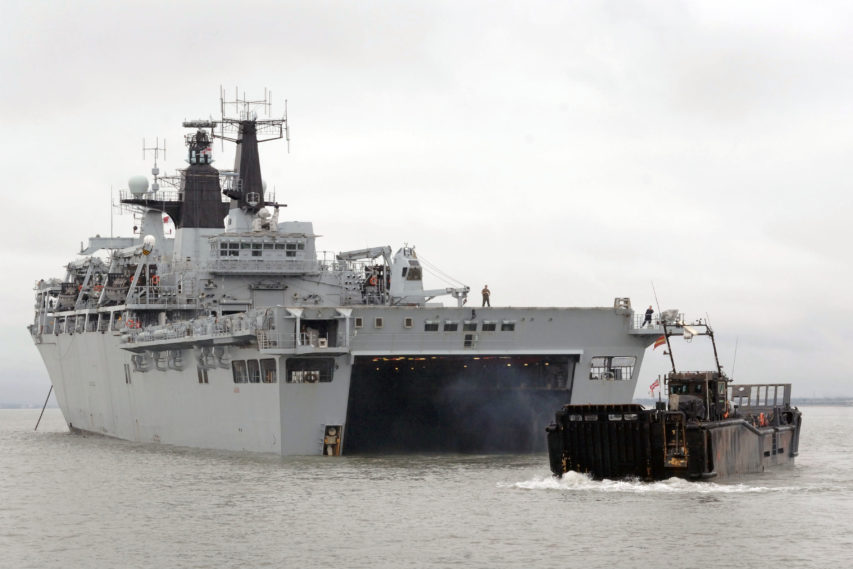
HMS Albion conducts amphibious operations with Landing Craft Utility (LCU) during Exercise Grey Heron off the coast of Portsmouth in 2007.
The Albion Class, Landing Platform Dock ships (LPD) primary function is to embark, transport, and deploy and recover (by air and sea) troops and their equipment, vehicles and miscellaneous cargo, forming part of an Amphibious Assault Force.
(Photo via Wikimedia)
The challenge for the Royal Marines [RM] right now is that they look particularly vulnerable targets, with a highly specialised core role that is increasingly unlikely to be used in anger. The RM and the RN [Royal Navy] have long had a slightly odd, and at times, uneasy relationship. It is often forgotten these days that the role of amphibious warfare isn’t something that really took off until WW2, and that the RM have only been leading on it for about 70 years. Until that point they were arguably merely light infantry embarked on ships and the odd landing party.
[…]
The key point where things began to change was arguably OP HERRICK. At this point the Corps transitioned from being an organisation which fought from the sea onto the land, to one that spent many years focusing on being a land based warfighting force. The depth of commitment to HERRICK meant that the Corps lost a lot of its links to the wider RN; speaking to friends who served in the RM, many remark that during the HERRICK years the RM did very little with the RN at sea. This would have been fine for a short operation, but for a multi-year commitment it meant that an entire generation of Officers and NCOs were growing up who excelled at conventional land warfare, but who had lost touch with their maritime roots.
At the same time, there was a growing sense in some parts of the RN that the RM was arguably a money pit that cost the RN a significant amount of time, money and platforms, but which delivered very little for the RN itself. Tellingly, during the worst years of the piracy issues in Somalia, the RN had to rely heavily on RNR ratings to form ships protection teams, not RM in part reportedly because the RM was so focused on Afghanistan. At a time when the RN was taking heavy cuts to ships and other platforms as part of budget reductions to help deliver success in Afghanistan, there was perhaps some resentment that the Corps delivered little, yet absorbed a huge amount of the Naval Service budget. What is the point of having an amphibious fleet, and maritime amphibious helicopter capability, if your amphibious troops are stuck in a cycle of deploying only to a landlocked country?
[…]
In the current security environment that the UK faces, it is hard to see a need for a major amphibious lift capability to conduct opposed operations. This may sound like heresy to say, but if you consider that any major beach landing would be fraught with risk, and require major military support and logistical access to a port and airhead quickly to succeed, it is hard to see the circumstances where the UK and US would want to conduct such an operation. The political circumstances are such, that it is difficult to see the UK willingly wishing to indulge in a full scale amphibious assault against a hostile nation with a brigade sized force anytime in the future.
There are plenty of situations where the ability to transport equipment and people is vital – for instance conducting a NEO [Noncombatant Evacuation Operation], or moving troops and supplies into a friendly country ahead of a wider land conflict. There are also circumstances where an ‘amphibious raid’ capability is equally important – the ability to quickly send a small number of troops ashore via helicopter or fast landing craft to conduct a specific mission, or diversionary raid is extremely useful.
[…]
For the RM, the chance to re-embark at sea and focus on maritime counter piracy and security could be an opportunity to rebrand and reinvent the organisation, giving it a new lease of life. There is a real and pressing need to marinize the RM again, getting them used to being at sea, not permanently working ashore. At the same time it would free up a lot of highly trained infantry soldiers who could train to deliver boarding teams, and maritime counter piracy duties. This is a deeply complex role that requires a lot of training and support to get right, and is only going to grow in importance over the next few years.
Investing in niche roles such as this, or protection of nuclear weapons, and coupling this with a smaller ability to land raiding parties not brigades has the benefit of making the Corps far more valuable to keep in the long term. Right now it is arguably a light infantry brigade which has some other secondary duties tagged on the side. This is fine, but there are plenty of light infantry brigades out there, and probably too many soldiers in the Army as it is. If the RM were to refocus onto being sea going soldiers again, and deliver a small range of capabilities very well, then this makes them far harder to scrap entirely.
October 27, 2017
The ever-shrinking Royal Navy
In The Register, Gareth Corfield suggests that the Ministry is considering flogging off more RN ships to South America to try to balance the budget:
UK Defence Secretary Sir Michael Fallon has denied that vital British warships may be quietly sold to South American nations as part of the ongoing defence review, according to reports.
Helicopter carrier HMS Ocean, already earmarked for sale to Brazil when she is withdrawn from the Royal Navy next year, may be joined by Type 23 frigates, according to respected defence industry magazine Jane’s.
The Type 23s are the backbone of the Royal Navy’s anti-surface and anti-submarine capability. They are the fighting teeth of the RN, used to ward off potentially hostile surface ships and submarines alike.
Current plans are for the new Type 26 frigate to replace the ageing but capable Type 23s. These new ships are set to enter service from the middle of the next decade, with the old leaving service on the (approximate) basis of “one in, one out”.
HMS Albion conducts amphibious operations with Landing Craft Utility (LCU) during Exercise Grey Heron off the coast of Portsmouth in 2007.
The Albion Class, Landing Platform Dock ships (LPD) primary function is to embark, transport, and deploy and recover (by air and sea) troops and their equipment, vehicles and miscellaneous cargo, forming part of an Amphibious Assault Force.
(Photo via Wikimedia)Two crucial amphibious warships, HMSes Albion and Bulwark, are rumoured to be on the chopping block of current defence cuts. Without these two ships, the Royal Navy cannot carry out amphibious landings, in the sense of “put Royal Marines in smaller boats that they can sail to beaches”. Both ships (only one is in service at any one time because we have neither the money nor manpower to run both at once) are fitted with big ramps and well docks allowing troops and vehicles aboard to be quickly loaded into landing craft.
Without its amphibious landing capability, the UK would not have been able to take the Falkland Islands back from Argentinian invaders after the 1982 invasion.
July 16, 2017
Royal Marines – Anonymous Warfare – Latvian Riflemen I OUT OF THE TRENCHES
Published on 15 Jul 2017
Time for another exiting episode of Out Of The Trenches where Indy (and this time also Flo) answer your questions about the First World War.
June 13, 2017
Roger Courtney and a Watery Gamble – The Establishing of the SBS
Published on 4 Jun 2017
In this video:
Described by the BBC as the “Shadowy sister of the SAS”, The Special Boat Service (more commonly known as the SBS) is likely one of the most well-trained and elite special forces units around today that few in the world have ever heard of, despite performing countless harrowing missions, dozens of hostage rescues and more than its fair share of daring night time raids going all the way back to WWII when an officer by the name of Roger “Jumbo” Courtney risked a court-martial to demonstrate to his superiors just how valuable a unit like the SBS could be.
Want the text version?: http://www.todayifoundout.com/index.php/2015/05/roger-courtney-establishing-special-boat-service/
May 15, 2017
Comparing Royal Marine field ration packs
A fascinating insight into the way the Royal Marines take care of the troops in the field, showing both enlisted mens’ and officers’ ration packs:
May 19, 2015
The 1982 amphibious landings at San Carlos Water
Think Defence looks back at the successful amphibious landings in the Falkland Islands by a less-than-fully-prepared British military:
If the amphibious operations in Normandy were unprecedented because of the scale those in 1982 in the Falkland Islands were equally remarkable, nor for scale but for the huge distance involved. Another breathtaking feature of Operation Corporate was the speed in which it was mounted and the degree of improvisation that would in the end, be needed.
One might argue that even taking into account Inchon and Suez it was the worlds most complex and demanding amphibious operation since D-Day.
Since VE day and Suez the UK’s amphibious capabilities had dwindled both in scale and capability, the Royal Marines concentrating on their Northern Europe role.
When Argentina invaded the Falkland Islands in 1982 the scale of the challenge had many echoes of D-Day; a need for joint service cooperation and a number of technical challenges to overcome for example. What we did not have was the luxury of time, no time to develop new and novel solutions, no time for testing and no time for practice beyond what was available on the journey south.
Due to the short timescales British Rail could not reposition their rolling stock to get the War Material Reserve (about 9,000 tonnes just for 3CDO, 30 days combat supplies and 60 days of general stores) to the ships so instead, a fleet of RCT and civilian trucks were used.
More or less, we went with what we had.
In little over a month from the invasion, the first ships had departed the UK on their 8,000 mile journey South.
There is no need to recount the general history of the campaign but from a ship to shore logistics perspective there were a number of equipment and capabilities available to Commodore Clapp and Brigadier Thompson worth describing.
Earlier posts on the Falklands War can be found here.
February 27, 2012
BBC: Could Britain still defend the Falkland Islands?
The BBC has a then-and-now summary of the military balance in the south Atlantic in 1982 and today:
1982: On the eve of the invasion, there were about 70 Royal Marines stationed on the islands — twice the usual number due to a changeover. They were, in theory, backed up by about 120 local reservists, although only a small proportion reported for duty. HMS Endurance, an Antarctic ice patrol vessel, was the only ship based in the South Atlantic at the time. And there were no fighter jets — none of the island’s airstrips were long enough. The only planes that could land before the war came from Argentina. Supplying the Falklands by sea from Britain took two weeks.
2012: The major difference is the construction of RAF Mount Pleasant, a modern air base housing four Eurofighter Typhoon strike fighters, a Hercules transport plane and VC-10 tanker plane. There are also Rapier missile batteries in several locations. The British garrison numbers 1,200, including 100 infantrymen, with 200 reservists in the Falkland Islands Defence Force. The Royal Navy has a patrol vessel, an auxiliary support ship, and frigate or state-of-the-art destroyer. It’s reported that a British nuclear-powered submarine is in the South Atlantic, but the Ministry of Defence will not discuss operational matters. “It’s quite a considerable deterrent force,” says Peter Felstead, editor of Jane’s Defence Weekly. Military experts believe the islands are now virtually impregnable. Any sign of Argentine invasion and the islands could be quickly reinforced by air.
Just as we established the last time this was up for discussion, Argentina doesn’t have the military forces for a stand-up fight, but if they can take the RAF base in a surprise attack by special forces, Britain probably can’t recapture the islands.
January 17, 2012
Details on the British defence cuts
The unit hardest hit by the reductions will be the Brigade of Gurkhas:
In a statement, the MoD revealed it was looking to shed 2,900 posts from the army, around 1,000 from the RAF and 300 from the Royal Navy.
The total is higher than the first round of the process last year, and there are expected to be more compulsory redundancy notices this time.
The MoD announced it was looking to shed approximately 400 Gurkhas — one in eight of the brigade. Approximately 500 infantry privates with more than six years’ service will also be axed.
The senior ranks of the army have not been spared. Eight brigadiers and 60 lieutenant colonels are expected to go.
The Royal Navy will lose five commodores and 17 captains. Nineteen Royal Marine officers will be shed, but no one from the ranks.
The RAF will lose up to 15 air commodores and 30 group captains. The MoD believes that by slowing recruiting, and not replacing those who leave, the navy and the RAF will be able to achieve the cuts they need without a “tranche 3” of redundancies. The army needs to shed almost 20,000 jobs over the next eight years and will continue to make cuts for years to come.

